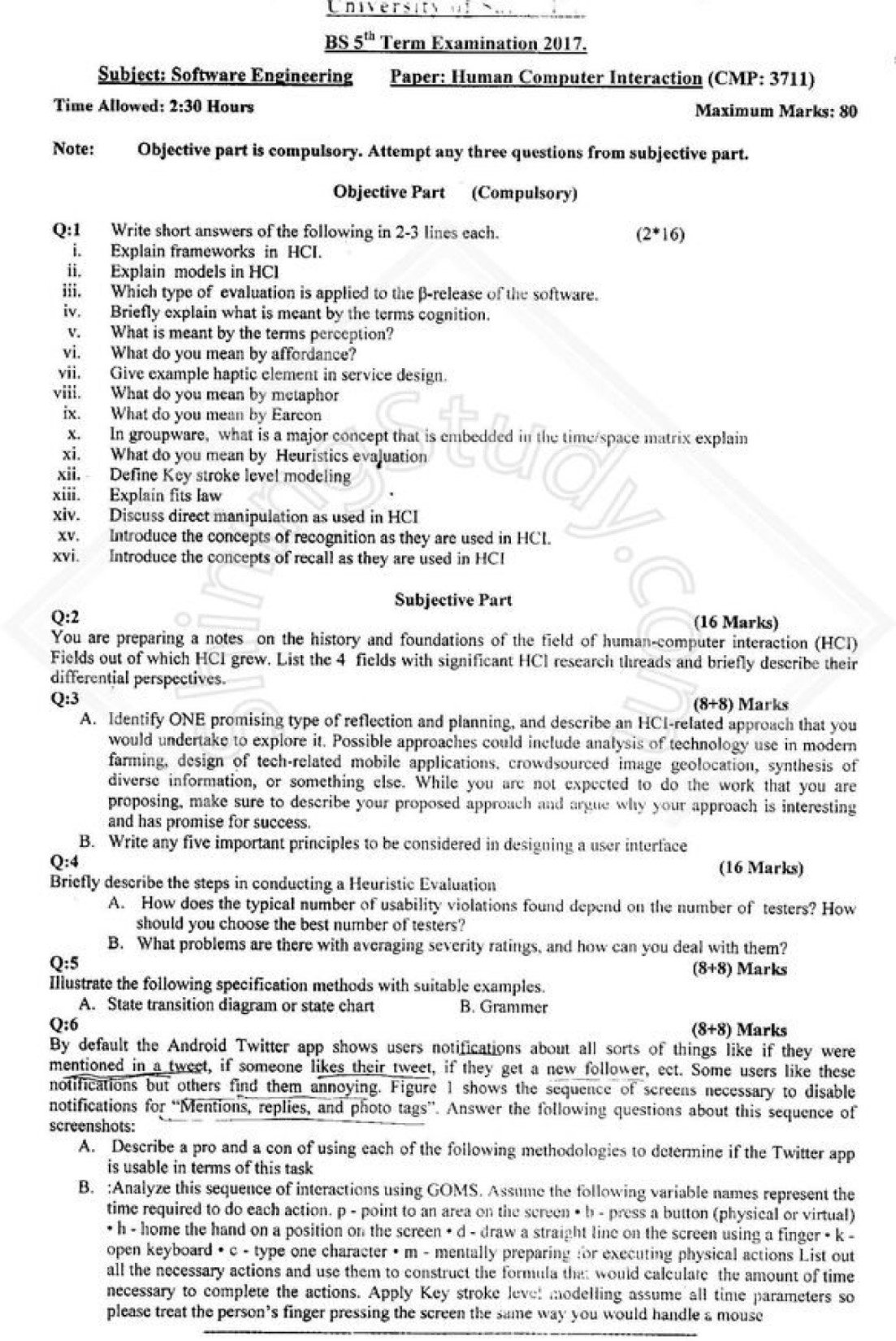Human Computer Interaction BSSE 5th Term Past Paper 2017 UOS

University of Sargodha
BS 5th Term Examination 2017
Subject: Software Engineering
Paper: Human Computer Interaction (CMP: 3711)
Maximum Marks: 80
Time Allowed: 2:30 Hours
Objective Part (Compulsory)
Q:1 Write short answers of the following in 2-3 lines each. (2×16)
i. Explain frameworks in HCI.
ii. Explain models in HCI.
iii. Which type of evaluation is applied to the β-release of the software.
iv. Briefly explain what is meant by the terms cognition.
v. What is meant by the terms perception?
vi. What do you mean by affordance?
vii. Give example haptic element in service design.
viii. What do you mean by metaphor?
ix. What do you mean by Earcon?
x. In groupware, what is a major concept that is embedded in the time/space matrix — explain.
xi. What do you mean by Heuristics evaluation?
xii. Define Keystroke level modeling.
xiii. Explain fits law.
xiv. Discuss direct manipulation as used in HCI.
xv. Introduce the concepts of recognition as they are used in HCI.
xvi. Introduce the concepts of recall as they are used in HCI.
Subjective Part
Q:2 (16 Marks)
You are preparing a note on the history and foundations of the field of human-computer interaction (HCI) Fields out of which HCI grew. List the 4 fields with significant HCI research threads and briefly describe their differential perspectives.
Q:3 (8+8 Marks)
A. Identify ONE promising type of reflection and planning, and describe an HCI-related approach that you would undertake to explore it. Possible approaches could include analysis of technology use in modern farming, design of tech-related mobile applications, crowdsourced image geolocation, synthesis of diverse information, or something else. While you are not expected to do the work that you are proposing, make sure to describe your proposed approach and argue why your approach is interesting and has promise for success.
B. Write any five important principles to be considered in designing a user interface.
Q:4 (16 Marks)
Briefly describe the steps in conducting a Heuristic Evaluation.
A. How does the typical number of usability violations found depend on the number of testers? How should you choose the best number of testers?
B. What problems are there with averaging severity ratings, and how can you deal with them?
Q:5 (8+8 Marks)
Illustrate the following specification methods with suitable examples.
A. State transition diagram or state chart.
B. Grammar.
Q:6 (8+8 Marks)
By default the Android Twitter app shows users notifications about all sorts of things like if they were mentioned in a tweet, if someone likes their tweet, if they get a new follower, etc. Some users like these notifications but others find them annoying. Figure 1 shows the sequence of screens necessary to disable notifications for “Mentions, replies, and photo tags”. Answer the following questions about this sequence of screenshots:
A. Describe a pro and a con of using each of the following methodologies to determine if the Twitter app is usable in terms of this task.
B. Analyze this sequence of interactions using GOMS. Assume the following variable names represent the time required to do each action:
p – point on the screen,
b – press a button (physical or virtual),
h – home the hand on a position on the screen,
d – draw a straight line on the screen using a finger,
k – open keyboard,
c – type one character,
m – mentally preparing or executing physical actions.
List all the necessary actions and use them to construct the formula that would calculate the amount of time necessary to complete the actions. Apply Keystroke level modeling assuming all time parameters so that you can predict the person’s finger pressing the screen the same way you would handle a mouse.
For more past papers, visit Shining Study – Past Papers Collection
